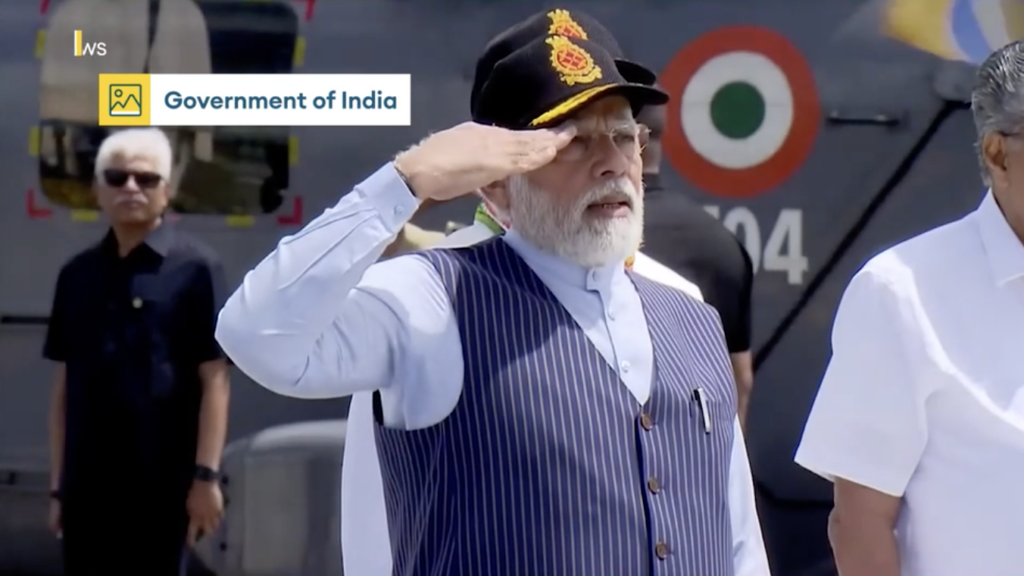First look at Indian Navy’s new ensign after St George’s Cross dropped
The new design breaks from the country’s colonial past and its historic links to British rule.
2nd September 2022 at 5:22pm

India has unveiled a new naval ensign as part of national efforts to move away from its colonial past under British rule – with a new Indian Navy flag that drops the St George’s cross from the design.
The new flag, unveiled for the first time on Friday, replaces its former ensign that bore close similarities to the British Royal Navy’s White Ensign, ending hundreds of years of association with Britain’s naval fleet.
Prime Minister Shri Narendra Modi saluted as the new ensign was hoisted during a ceremony to officially commission the country’s first domestically-built aircraft carrier, the INS Vikrant.
- The White Ensign: A brief history of the iconic Royal Navy flag
- Britain and India: From Imperial opportunism to liberal self-determination
- Union Jack: Do you know the correct way up?
It gave the world the first look at the new flag, as it looks in situ, flying from a navy warship.
The Prime Minister’s Office of the Government of India said that the flag was resonant with the ongoing national endeavour to move away from the country’s colonial past and it was felt that there was a need to transition to a new design that drew inspiration from India’s own history.

India’s naval ensign has until now closely resembled the Royal Navy’s White Ensign, complete with the St George’s Cross on a white flag – a throwback to the era when India’s navy was named Her Majesty’s Indian Marine under the command of the British government of India in 1877.
The ensign of the Indian Navy has been changed several times before but the St George’s Cross has remained a feature in modern times.
Its colonial associations are a reminder of the country’s past under the command of the British Empire, and the country’s naval links to the Royal Navy.
The Indian Navy’s new White Ensign now comprises two main constituents – India’s national flag in the upper left canton, and a navy blue and gold octagon at the centre of the fly side, away from the staff.
The octagon includes twin golden octagonal borders encompassing the golden national emblem, the Lion Capital of Ashoka – underscored with the words of a mantra from Hindu scripture, ‘Satyamev Jayate’, in blue Devnagri script, resting on top of an anchor and superimposed on a shield.
Below the shield, within the octagon, in a golden bordered ribbon, on a navy blue background, is inscribed the motto of the Indian Navy ‘Sam No Varunah’ in golden script, meaning ‘Be auspicious unto us, Oh Varuna’, which is a call to Varuna, the Hindu god of the ocean.
The design encompassed within the octagon has been taken from the Indian naval crest, replacing an anchor design, that was associated with the Navy’s colonial legacy, with a new anchor design that the Indian government says underscores the steadfastness of the Indian Navy.
Prime Minister Modi, unveiling the new ensign during the commissioning ceremony of the Vikrant, which the Indian government says is the largest warship to have ever been built in India and the first aircraft carrier designed and built at home for the Indian Navy, said: “INS Vikrant is a symbol of indigenous potential, indigenous resources and indigenous skills.”
The prime minister, dedicating the new ensign to the Indian ruler of the 1600s, Chhatrapati Shivaji, added: “Until now, the identity of slavery remained on the flag of the Indian Navy. But from today onwards, inspired by Chhatrapati Shivaji, the new Navy flag will fly in the sea and in the sky. “Many women soldiers of the Navy will be stationed on Vikrant. With the immense power of the ocean, boundless female power, it is becoming the lofty identity of the new India.”
